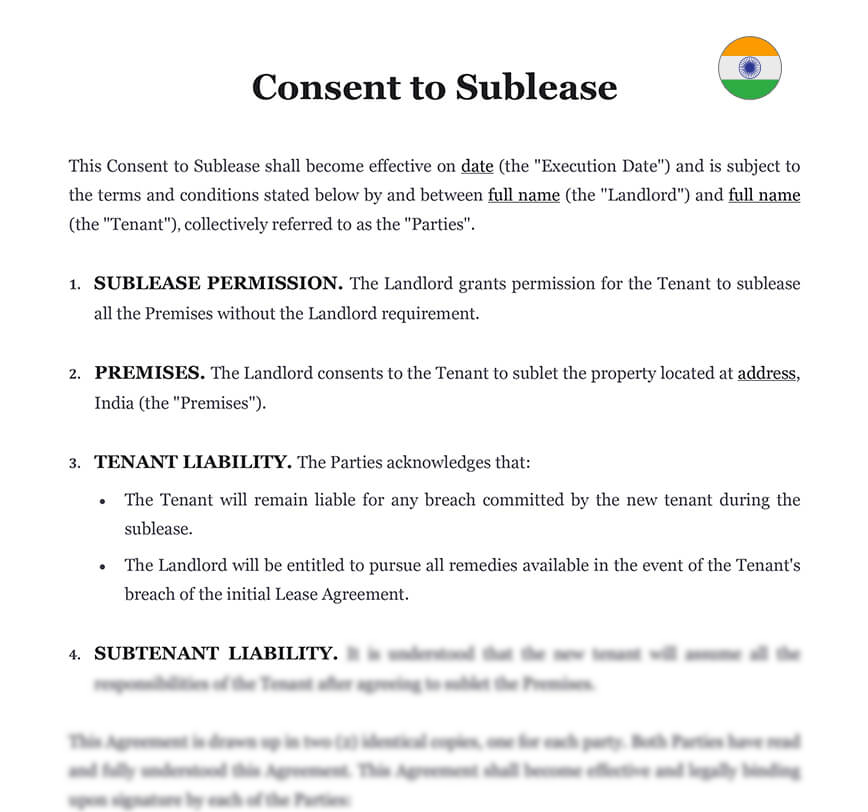Ready to use legal template
Drafted by experienced lawyers
Compliant with Indian law
Ready to use legal template
Drafted by lawyers
Compliant with Indian law
Home › Rent your property › Consent to sublease
Learn more about Consent to Sublease in India
Under Indian law, a Letter of Agreement to sublease permits a present tenant to sublet his or her accommodation. It takes the form of a formal agreement signed by the landlord and the tenant enabling subletting for a period no longer than the original Lease Agreement‘s length. When the renter is absent on occasion, subletting might be an option. It enables rent to be paid while the renter is absent. It also permits a current renter to split the rent with someone with whom they want to share the flat temporarily. When signing the Sublease Agreement, the tenant must give a copy of the landlord’s written authorisation to the subtenant. A copy of the current master lease agreement must also be provided by the Tenant.
Table of contents
What is a Consent to Sublease Letter?
A permission to sublet is a legal document that both the landlord and the tenant must sign in order for the renter to start a new lease with someone else. This contract contains explicit wording defining who can reside on the property, how much rent will be paid, and what sorts of housing units are permitted.
If there are no restrictions or limitations on occupation under the present Lease Agreement, a permission to sublease is not required. The most typical reason for an owner wanting their renter to sign this paperwork is that they want to sell their house while it is still inhabited.
What are the reasons for subletting?
Subletting might provide flexibility within your rental agreement if it is accessible to you.
If you need to relocate, subletting allows you to do so without facing the costs and penalties that come with breaking a lease. If you gain a new job or discover a nicer apartment that meets your needs, subletting allows you to go without having to worry about paying rent on two apartments. Discuss with your sublessee and landlord if the subletter will be able to take over the unit permanently after your lease expires.
If you want to go on a long trip but don’t want to give up your rental or furniture, a sublet can help you maintain your lease while you’re away.
If you live with roommates, family members, or partners, it may make more sense to sublease a portion of the rent rather than adding them to the lease.
How to give permission to sublease?
To protect oneself legally, it is critical to be diligent in every stage of the subletting process. Here’s a rundown of the procedure:
Step 1. Investigate local legislation
Even if subletting is permitted in your location, it’s a good idea to examine the restrictions and obstacles to verify they’re a suitable fit for your scenario.
Speak with your landlord. Some lease agreements may enable subletting on a case-by-case basis, but others do not, so double-check your lease before proceeding. Still, it’s worth contacting your landlord to amend your lease agreement to allow sublets, or to obtain approval from them. Make sure to inquire about the subletting process with your landlord: Will potential subletters be required to fill out forms and pay fees? How much time will it take them to approve your subletter?
Step 2. Look for a subletter
Inquire with friends and relatives if they know of anyone seeking a sublease. (A straight recommendation will be simpler to vet afterwards.) Otherwise, try posting on social media and apartment listing sites, or seek for services tailored exclusively to prospective sublessors. Keep some nice images of the property available, and write a description of the place that is honest while highlighting its virtues.
Step 3. Give tours to everyone who is interested
Most prospective parties will want to visit the house before asking about a sublease arrangement. Prepare your place ahead of time so that visitors leave with a pleasant impression. If in-person visits are not possible, video-conferencing software can be used.
Step 4. Applicants must be thoroughly vetted
To guarantee you’re subletting to the proper individual, make sure they meet your income and temperament requirements. In some situations, your landlord may wish to be a part of this process. Request evidence of income and credit score, as well as references from previous jobs, landlords, or roommates. Consider using the services of a background check provider, depending on your budget. Finally, interview prospective subletters to determine if they intend to utilize the area in a way that corresponds to your tastes and degree of comfort. If you have roommates, include them in the process so they feel at ease.
Step 5. Create a sublease agreement
Once you’ve found a qualified potential subletter, draught your tenancy agreement or adapt an internet form to fit your needs. (This agreement may also be provided by your landlord.) This agreement should include a move-in and move-out date, the rent and utilities for which the subletter will be liable, and what furniture or possessions (if any) will stay in the apartment. Consider collecting a security deposit in the event that the subletter causes damage to the flat or your things.
Step 6. Make a sublease agreement
Once you’ve found a qualified potential subletter, draw out the terms of your tenancy agreement or edit an online form to fit your needs. (Your landlord may also supply this agreement.) This agreement should include a move-in and move-out date, the rent and which utilities the subletter will be liable for, and what furniture or possessions (if any) will stay in the flat. Consider collecting a security deposit in case the subletter destroys the unit or your things.
Is Subleasing legal in India?
Subletting with the landlord’s permission is permitted in India. If the agreement allows it, the tenant may sublet a portion of the property to a third party. Subleasing occurs when a tenant whose name appears on the lease rents a room, a piece of the property, or the entire property to another (or subletting). The subtenant must pay rent and follow the lease requirements, but the primary tenant is ultimately liable for the lease.
Can a Tenant sublet without permission?
Any subletting by a tenant must be done with the written agreement of the landlord who has leased the premises to the tenant. If the landlord does not provide the tenant formal permission to sublease, any subletting done by the tenant is unlawful, and the renter should be evicted from the premises.
What are Tenant and Subtenants responsibilities?
When subleasing an apartment, the original renter should do everything possible to select someone they believe is trustworthy and will continue to pay the rent. The major reason for doing so is because the original renter is still responsible for ensuring that the rent is paid. The subtenant is usually not required to respond to the landlord; the landlord can often only sue the original tenant for rent. If the subtenant fails to pay the rent on time, the landlord has the right to remove the original tenant. If the subtenant owes many months of overdue rent, the original tenant must ensure that it is paid. Similarly, even if they are no longer living there, the original renter is responsible for keeping the rental in excellent condition.
SPECIAL OFFER
Landlord
10 Document Package
Essential documents for managing rental property in India
Consent to Sublease LetterTemplate (.docx)
Easy and quick to customize
310 client reviews (4.8/5) ⭐⭐⭐⭐⭐
Share information
Why Themis Partner ?
Make documents forhundreds of purposes
Hundreds of documents
Instant access to our entire library of documents for India.
24/7 legal support
Free legal advice from our network of qualified lawyers.
Easily customized
Editable Word documents, unlimited revisions and copies.
Legal and Reliable
Documents written by lawyers that you can use with confidence.




